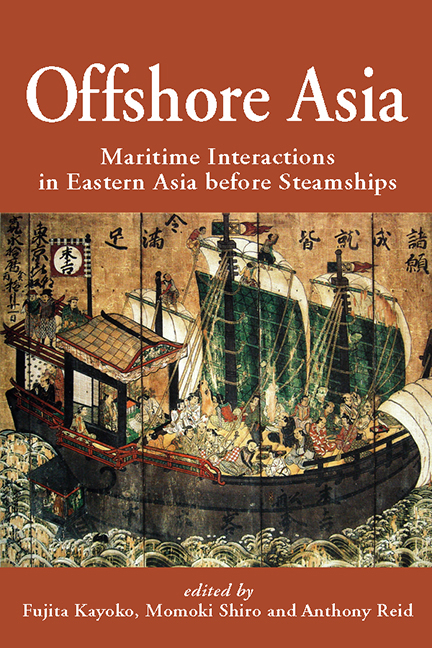Book contents
- Frontmatter
- Contents
- Maps
- Tables and Figures
- Preface
- Contributors
- Map 1 Eastern Asia in the 13th–16th Centuries
- 1 Introduction: Maritime Interactions in Eastern Asia
- 2 The Periodization of Southeast Asian History, in Comparison with that of Northeast Asia
- 3 Merchants, Envoys, Brokers and Pirates: Hokkien Connections in Pre-modern Maritime Asia
- 4 An Asian Commercial Ecumene, 900–1300 ce
- 5 The Japanese Archipelago and Maritime Asia from the 9th to the 14th Centuries
- 6 Saltpetre Trade and Warfare in Early Modern Asia
- 7 Shaping Maritime East Asia in the 15th and 16th Centuries through Choson Korea
- 8 Shipwreck Salvage and Survivors’ Repatriation Networks of the East Asian Rim in the Qing Dynasty
- 9 Wei Zhiyan and the Subversion of the Sakoku
- 10 Metal Exports and Textile Imports of Tokugawa Japan in the 17th Century: The South Asian Connection
- Bibliography of Works Cited
- Index
- NALANDA-SRIWIJAYA SERIES
1 - Introduction: Maritime Interactions in Eastern Asia
Published online by Cambridge University Press: 21 October 2015
- Frontmatter
- Contents
- Maps
- Tables and Figures
- Preface
- Contributors
- Map 1 Eastern Asia in the 13th–16th Centuries
- 1 Introduction: Maritime Interactions in Eastern Asia
- 2 The Periodization of Southeast Asian History, in Comparison with that of Northeast Asia
- 3 Merchants, Envoys, Brokers and Pirates: Hokkien Connections in Pre-modern Maritime Asia
- 4 An Asian Commercial Ecumene, 900–1300 ce
- 5 The Japanese Archipelago and Maritime Asia from the 9th to the 14th Centuries
- 6 Saltpetre Trade and Warfare in Early Modern Asia
- 7 Shaping Maritime East Asia in the 15th and 16th Centuries through Choson Korea
- 8 Shipwreck Salvage and Survivors’ Repatriation Networks of the East Asian Rim in the Qing Dynasty
- 9 Wei Zhiyan and the Subversion of the Sakoku
- 10 Metal Exports and Textile Imports of Tokugawa Japan in the 17th Century: The South Asian Connection
- Bibliography of Works Cited
- Index
- NALANDA-SRIWIJAYA SERIES
Summary
The historical scholarship of the nationalist age in the second half of the 20th century achieved much in understanding the roots of Southeast Asian national cultures and the resilience of each of them in maintaining an autonomous dynamic despite imperial pressures. Among the models energetically rejected by that era were not only European and Japanese imperial ideas of a civilizing mission, but the “Greater India” school celebrating Indian cultural expansion in the first millennium of the Common Era, and Sino-centric notions of a Chinese world order extending its influence into Southeast Asia. The new national historians insisted on disentangling their pasts, as well as their presents, from the stories of others. Busy building new pasts to match and legitimate their new futures, they had neither time nor inclination to explore more regional themes. Comparison and connection within Asia and beyond it has only recently returned to the agenda, not before time in a globalizing world.
In the West there was also much sympathy for decolonizing history and for exploring the roots of the new nationalist and radical forces transforming society. But the single-country focus was modified from the 1970s by an area studies approach to organizing knowledge, dominant in the U.S. and to some extent English-medium scholarship more generally in this period. In the classroom, and increasingly in books that served the classroom, Southeast Asian history was often taught as a whole. To a lesser extent those studying China, Japan and Korea outside that region had to know something about Northeast Asia as a whole. But the more these area-focussed textbooks sought a particular character for Southeast (or Northeast) Asia, however, the more they emphasized its distinctiveness from each of the other conventional regions. The maritime and commercial character of Southeast Asia, open to external influences, was contrasted to the self-sufficient Confucian societies of the Northeast, ideologically inclined to exalt agriculture and scholarship in contrast with commerce. The fluid, plural and kinship-based political systems of the Southeast were contrasted with the relatively bureaucratic, bookish and “earthbound” states of the Confucian tradition.
- Type
- Chapter
- Information
- Offshore AsiaMaritime Interactions in Eastern Asia before Steamships, pp. 1 - 15Publisher: ISEAS–Yusof Ishak InstitutePrint publication year: 2013



